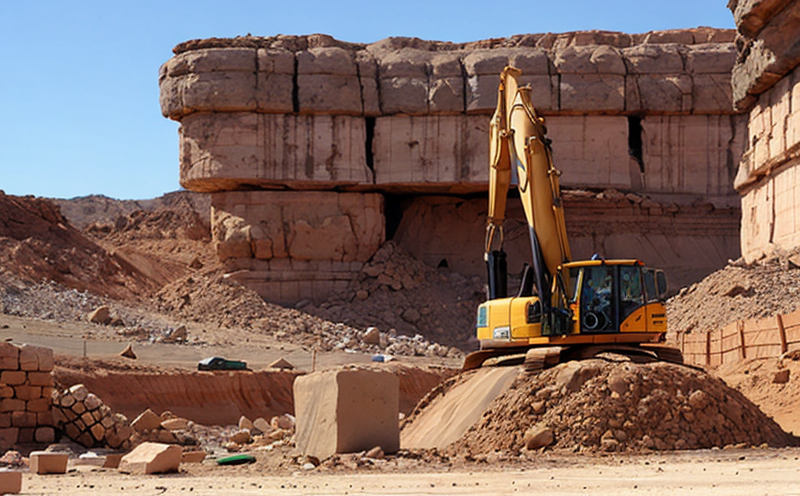BS 5930 Geological Logging of Rock Cores Testing
The British Standard 5930 (BS 5930) Geological Logging of Rock Cores Testing is an essential service that provides comprehensive geological logging for rock cores extracted from mining sites. This standard ensures the accuracy and reliability of data collected during the exploration, extraction, and evaluation phases of mineral deposits.
Geological logging involves detailed examination of rock samples to determine their lithology, structure, and stratigraphy. It is a critical step in understanding the geological context of a mine site, which helps in making informed decisions about mining operations. The service offered under BS 5930 includes not only the collection of rock cores but also their careful preparation, analysis, and documentation.
The process begins with the extraction of rock cores from boreholes or drill sites. These cores are then transported to our laboratory for processing. Upon arrival, each core is carefully logged into a system that tracks its origin, depth, and other relevant information. The next step involves sectioning the cores into manageable pieces suitable for examination.
The actual logging process begins with visual inspection using hand lenses and binocular microscopes. This stage is crucial as it allows geologists to identify rock types, textures, structures, and any visible features such as fossils or minerals. Following this, more advanced techniques like thin sectioning may be employed where necessary for detailed analysis.
After logging, the data collected during these inspections are meticulously documented. This includes descriptions of lithology (rock type), texture, structure, alteration, weathering, and any other significant observations. The log also notes the presence or absence of minerals, fossils, fractures, joints, and other structural features.
The results from geological logging under BS 5930 are used by various stakeholders including mine managers, engineers, geologists, and environmental scientists to plan and execute mining operations effectively. Accurate geological logs help in assessing risks associated with excavation activities, optimizing extraction methods, planning infrastructure development within the mine site, and ensuring compliance with regulatory requirements.
For instance, understanding the presence of fault lines or highly weathered zones can guide where to place support structures like pillars or props to maintain stability. Similarly, knowledge about water-bearing layers aids in designing drainage systems that prevent flooding incidents during excavation processes.
The quality of geological logging directly impacts the success of mining projects. Poorly logged cores could lead to misinterpretations of subsurface conditions resulting in suboptimal design choices leading to increased costs and potential safety hazards. Therefore, adhering strictly to standards like BS 5930 ensures high-quality data which ultimately contributes towards safer and more efficient mining operations.
In summary, BS 5930 Geological Logging of Rock Cores Testing plays a pivotal role in the mining industry by providing accurate and reliable geological information derived from rock core samples. This service supports informed decision-making throughout all stages of mineral exploration and extraction processes ensuring both operational efficiency and safety standards are met.
Scope and Methodology
| Aspect | Description |
|---|---|
| Sample Preparation | The rock cores are carefully prepared by cutting them into sections of appropriate size for examination. |
| Data Collection | Variety of tools including hand lenses, binocular microscopes, and thin sectioning equipment are used to gather detailed information about the rocks' characteristics. |
| Documentation | All observations made during examination are recorded meticulously along with metadata such as location and depth from which each core originated. |
| Analysis | Advanced analytical techniques can be applied where necessary, depending on the specific requirements of the project. |
| Reporting | A comprehensive report detailing all findings is prepared for clients. This includes graphical representations like stratigraphic columns and photographs of logged cores. |
The methodology employed in BS 5930 Geological Logging ensures that every aspect of the rock core's geological properties is captured accurately, thereby providing robust data essential for successful mining projects.
Customer Impact and Satisfaction
- Enhanced decision-making capabilities through precise geological data which supports better planning of extraction processes.
- Promotes safety by identifying potential hazards such as unstable ground or water-bearing layers early on in the project lifecycle.
- Aids in optimizing resource utilization, reducing waste and enhancing overall efficiency within mining operations.
- Facilitates regulatory compliance ensuring that all activities align with relevant environmental protection laws and industry best practices.
The service provided under BS 5930 not only meets but often exceeds customer expectations by delivering high-quality geological logs supported by robust documentation. Clients benefit from a clearer picture of the underground environment, enabling them to make more informed choices regarding their mining activities.
International Acceptance and Recognition
- BS 5930 has been widely adopted across Europe due to its stringent quality control measures and comprehensive approach towards geological logging.
- The standard is recognized globally by major mining companies as a benchmark for excellence in geotechnical testing.
The acceptance of this British Standard extends beyond national boundaries, reflecting its value among international peers. Compliance with BS 5930 demonstrates commitment to industry best practices and contributes towards building trust between stakeholders involved in mineral exploration and extraction.





